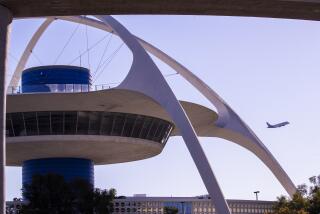Runway Work Forcing Flights Lower, Louder
- Share via
Planes landing at John Wayne Airport are flying lower and straying west of the normal approach on cloudy days because key navigational equipment has been ordered shut down during runway construction, officials said Wednesday.
Although the airport has received about 100 complaints about noise in recent weeks as planes have flown over densely populated residential areas, the Federal Aviation Administration said the change in pattern is not a safety hazard.
Normally, planes are guided to land at John Wayne by the Instrument Landing System, or ILS, officials said. Air Line Pilots Assn. spokesman John Russell said the ILS guides pilots electronically over a route roughly over the Costa Mesa Freeway and an industrial area north of the airport, where noise pollution is minimized.
But airport spokeswoman Pat Markley said FAA officials ordered some ILS equipment shut down Aug. 17, when runway construction began, “because if the equipment was operating during construction, it could give out a false reading.”
Now, on cloudy days when pilots do not have a clear view of the runway from a distance, they are making a “non-precision approach” that relies on a local directional antenna, FAA officials said.
Markley said that the use of the directional antenna has resulted “in a little bit of a shift” to the west as planes begin their runway descent. This change has caused planes to fly over more densely populated residential area where aircraft noise is not normally a problem.
Pete Maddox, who lives in the affected area near Santa Clara and Tustin avenues in Santa Ana, said the “noise is unbelievable.”
“They come in very low and the noise is deafening,” said Maddox, who owns a computer business. “We live 11 miles from the airport, but when this happens we can’t talk to each other inside the house or on the telephone.”
John Leyerle, who handles noise complaints at John Wayne, said the airport has received about 100 complaints in recent weeks, mostly on overcast days.
But FAA spokesman Mitch Barker said the directional antenna is a “totally safe backup” to the ILS.
“We would not allow anything that was dangerous. . . . We worked with them [John Wayne officials] on this. They notified us, and we made the necessary adjustments in air traffic control to safely accommodate air traffic,” Barker said.
Officials said that on clear days, pilots use a visual approach to the runway, which usually takes them over the route commonly used in instrument landings. In instrument landings and visual approaches, pilots began descending at 2,600 feet, about 6 1/2 miles from the runway, Barker said.
But when relying on the directional antenna to guide them to the runway, pilots begin descending at 1,600 feet about 5.3 miles from the runway, he said.
“In an LDA approach, they are lower and west of where they would normally be [while descending]. If some people are hearing aircraft noise they’re not normally subjected to, that’s the reason,” Barker said.
John Wayne officials said the construction, designed to strengthen the south end of the commercial runway, will continue through the end of the month and possibly into early October.
(BEGIN TEXT OF INFOBOX / INFOGRAPHIC)
Changing Course
Runway construction has forced a temporary shift in procedures on cloudy days at John Wayne Airport, requiring pilots to make visual approaches rather than instrument landings. How the procedures differ:
Visual approach: Planes land on course west of Costa Mesa Freeway
Source: John Wayne Airport
Graphics reporting by BRADY MacDONALD / Los Angeles Times
More to Read
Sign up for Essential California
The most important California stories and recommendations in your inbox every morning.
You may occasionally receive promotional content from the Los Angeles Times.













